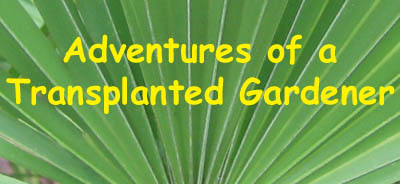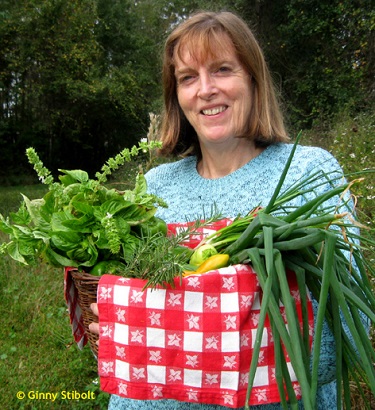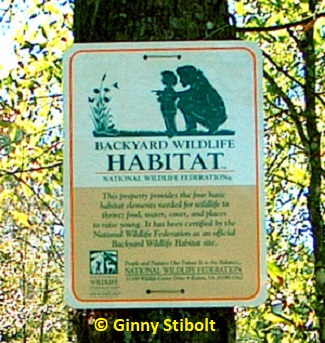Adventures of a Transplanted Gardener |
|||||
Creating backyard habitat
| |||||
|
|
Since moving into our house in the spring of 2004, we've been working on many projects to make our property more attractive to wildlife and to increase its environmental sustainability. I've written about many of these projects including: rain gardens, rain barrels, native plants in your landscape, reducing our lawn, meadows, and more.
I decided it was time to apply for a Backyard Wildlife Habitat certification from the National Wildlife Federation (NWF). Our yard is now officially NWF habitat #59063. I urge everyone to do this—it's not difficult and you don't need a large lot like ours.
There are four features that you must provide to have sustainable wildlife habitat:
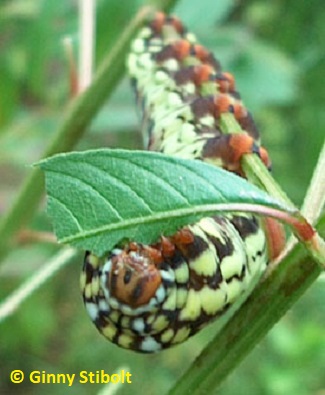 |
1) Food
You need to provide a minimum of three types of food: seeds, berries,
leaves, nuts, nectar, etc. Food is best supplied by plants and
animals in a balanced eco-system, but you may supplement the naturally-occurring
food with feeders. This is more important in colder
environments.
Many of the Transplanted Articles include more information on what we've done to create food for wildlife.
<<
Interesting and colorful hornworms, which are larvae of white-lined
sphinx moths (Hyles lineata), eat the leaves of the Peruvian
primrose-willow (Ludwigia peruviana), an invasive plant in Florida.
![]()
2) Water
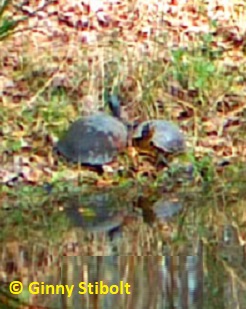 Two Cooter turtles bask |
You need to provide at least one source of water for
drinking and bathing. We used to love to watch Orioles, Cardinals
and Blue Jays use the bird bath on our deck in Maryland, but found
that here in Florida, the water in a bird bath got too hot and birds
wouldn't use it. But we have a pond in the front of our house
and Lake Asbury is at the back of our lot, so we qualified.
We've replaced the lawn at the edge of the pond with ferns and other
water-loving native plants to provide more interest and to reduce
the maintenance of a hard-to-mow area.
![]()
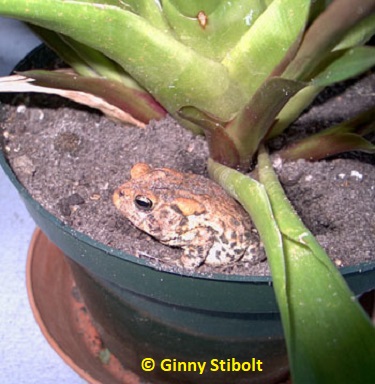 This little toad found cover |
3) Cover
Wildlife habitat requires shelter from weather and predators. You need to provide two types of cover such as: wooded areas; dense evergreens, shrubs, or bramble; brush piles; meadows; ponds; and even potted plants.
Our yard includes a number of these features,
but you don't need a big space to provide cover. ![]()
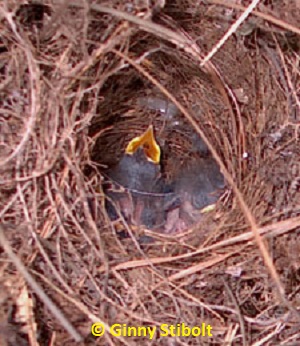 |
![]()
4) Places to raise young
While much of the cover and food features above double for this
category, the emphasis is different. This category also includes
nesting sites such as meadows, mature trees and dead trees or snags,
plus food for larvae and other young.
Three Carolina Wrens hatched from this nest in a plastic
pot where I was storing Sago pups on a rain barrel. Not what
we'd planned because for several weeks we stayed away from this
side our our garage so the birds would have some privacy, but we
can always use three more insect eating birds around here.![]()
Sustainable gardening
In addition to the four habitat features, NWF requires that you practice at least two sustainable gardening practices such as installing rain gardens, mulching & composting, reducing lawn areas, reducing erosion, reducing chemicals, and more. We've been working from the beginning to minimize environmentally negative conditions and to also reduce maintenance for our property. (Note: In retrospect, this part of the exercise was probably the inspiration for my first book, Sustainable Gardening for Florida.)
Then you need to create a plant list.
I've been paying attention and have identified most of the plants on our lot, but for this project, I created a plant list in a more organized manner. The plant list on our property included more than 100 species including the several invasive species that I'm working to eradicate.
It was a great feeling to get the NWF package in the mail and to post the sign on an oak tree at the front corner of the yard.
Schools can get certified, too.
Schoolyard Wildlife Habitats are like the backyard habitats and need to attract wildlife by providing the four elements crucial to wildlife survival: food, water, cover and places to raise young. To get certified, a Schoolyard Wildlife Habitat also needs to include learning opportunities for all ages across the curriculum. A Schoolyard Habitat will:
-
provide areas for teaching and learning about nature
-
restore habitat for wildlife
-
decrease mowing maintenance costs
-
provide alternative classroom setting
-
create beautiful places on campus
-
enhance biodiversity
Commercial landowners can be greener and save money
Forward-thinking commercial and municipal land managers are changing the way "things" are done. Native plantings are used along roadsides, in drainage ditches, and other hard-to-maintain areas. It saves water & money, enhances the water quality, and it makes us all feel better. What better way to celebrate National Wildlife Week and Earth Day than to have whole communities work together to enhance the environment?
~ ~ ~
Resources:
www.nwf.org/certify -- The National Wildlife Federation has been spearheading the backyard and schoolyard habitat certification since 1973. As of Feb. 2006 there are 60,000 certified habitats—their goal is to reach 70,000 by the end of the year to celebrate NWF’s 70th anniversary. Spread the word.
www.wildlifehc.org -- Wildlife Habitat Council helps large landowners manage their unused lands in an ecologically sensitive manner for the benefit of wildlife and the environment. It also has projects for backyard habitat preservation as well.
Ginny Stibolt is a life-long gardener, a botanist, a naturalist and a garden writer. You may contact her or read more of her articles posted on her website: www.greengardeningmatters.com.
Copyright Ginny Stibolt 2021
